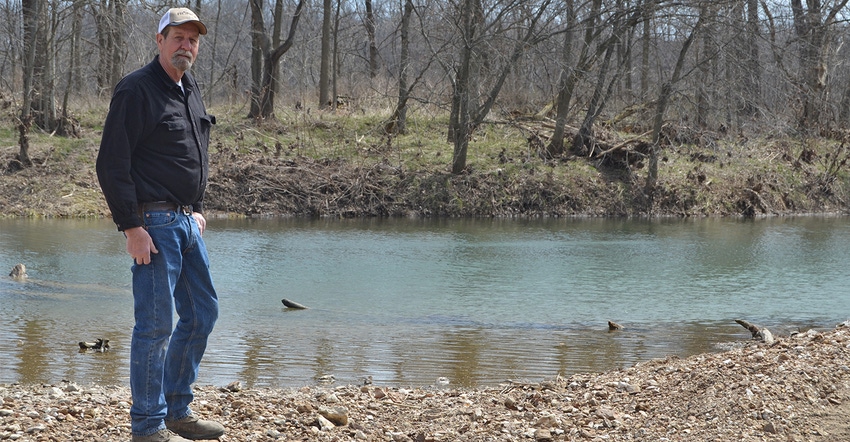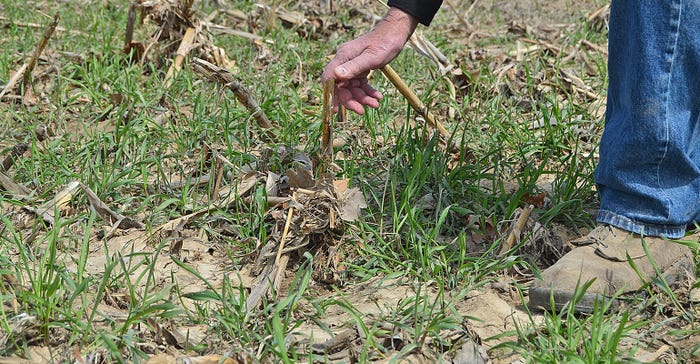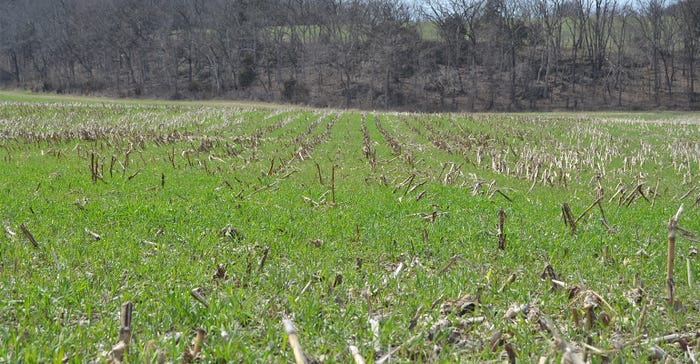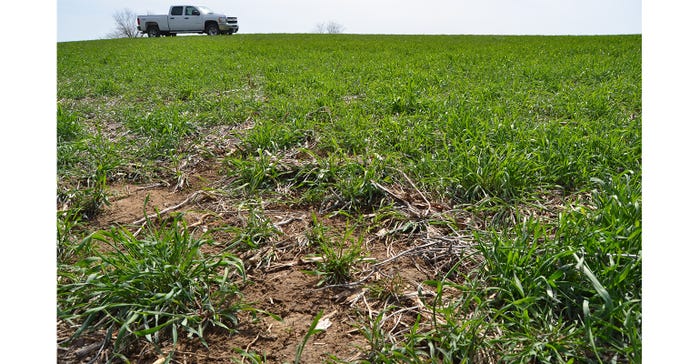
John Scherder is fighting to keep soil in place throughout the hills and valleys of rural Pike County, Mo.
The cattle and row crop farmer�’s operation includes highly erodible hillsides, along with creek bottom ground. Every year he faces the possibility of soil loss due to erosion.
“I hate ditches,” Scherder says. For years, he stood on the hilltop watching heavy rains cut in large gullies, taking with them soil and nutrients. Five years ago, he changed the landscape by adding cover crops.

IN PLACE: Combining no-till farming practices with cover crops allows the soil next to the creek bed to stay in place.

There are still areas with steep slopes — some up to 4% — and depressions that resemble small ditches, but there is one major difference: green cover. “It is doing its job,” he says, running his hands through the rye, “keeping the soil in place.”
It is a challenge to farm steep slopes and low creek-bottom ground. However, Scherder is using the same approach on both — no-till and cover crops — and finding good results.
Small-scale endeavor
Like many Missouri cattle producers, Scherder was left short on forage and feed after the drought of 2012. So, he sowed his first field of cover. “I planted rye,” he recalls. “We had a great fall, it rained and the crop was perfect.” He grazed it off with 40 cows.
What started as a forage-filler turned into a soil-saver when, in spring 2013, a local fish biologist visited the farm.
Soil erosion was a problem along the streambed. Large rain events caused the creek to rise, engulfing farmland. The biologist was concerned that as the water receded, it would erode the land. Scherder did not like his soil and nutrients leaving the land. Both thought cover crops could help. So, the biologist approached Scherder with a proposal to cost-share for seed.

GREEN IS GOOD: To Missouri farmer John Scherder, the sight of green across his low-lying field is welcome. He says cover crops are helping his farm keep soil on the land for the future.

In the lowlands
“See this stubble and this green,” he says, kneeling next to the remnants of last year’s corn harvest and the emergence of this year’s cover crop, “It is holding the soil in place, keeping it and nutrients from going into that creek.”
Scherder farms and lives in the largest watershed in the area — Peno Creek Watershed. The creek meanders throughout his land, where he plants corn and soybeans. His goal is to trap as much moisture as he can in the soil for his crops, which means improving soil health.
“I’ve learned that there is so much more going on below the surface than what we see above it,” he says. “By keeping green cover on my ground as much as I can all year-round, I am able to build organic matter in the soil and create a healthier base for crops and forage.”
He has roughly 800 acres planted to cereal rye. It provides not only cover, but also the option to harvest and bale for cattle forage.
However, before harvesting, Scherder plants his crop. “I like to plant green,” he says. He will spray to terminate the cover crop and plant at the same time — even when the weather does not cooperate.
In wet years, timing of termination and planting are often pushed back. Still, he plants into 6-foot-tall rye and comes out with 50-plus-bushel soybeans.
“At first it was about forage,” he says. “Then, it was to get rid of ditches and protecting the creek. Now it is about soil health and improving yields. They all work together.”

RID THE DITCHES: It is harder to see the ditch as cover crops fill in the gap, keeping soil in place.

Farmers take action
Area landowners are joining Scherder in the cover crop movement.
In 2013, five farm families in Peno Creek Watershed formed a landowner council. They work with the Missouri Department of Conservation to find practical ways to protect and improve the land and streams.
“That first year, there were 20 landowners who participated in planting cover crops,” Scherder says. “Today it has more than doubled and includes more than 2,000 acres.”
Since the Peno Creek Watershed is part of the Upper Mississippi River Basin, the group now works with Fishers and Farmers Partnership —a group of farmers, tribal organizations and state and federal agencies working together to protect the 30,700 miles of rivers and streams in the basin. The group serves to collaborate on conservation projects among farm landowners, farm operators, natural resource managers and local organizations.
Scherder says the partnership holds meetings and tours, where landowners can talk about what works and what doesn’t. “It has been a great resource for us,” he says. “It is important to work with other entities on land stewardship projects, especially for the future.”
As a grandfather, he along with his wife, Sandy, wants to leave the farm more productive for the next generation. “It all starts with saving the soil, keeping it on the land and giving it the opportunity to remain healthy.” he says.
About the Author(s)
You May Also Like






